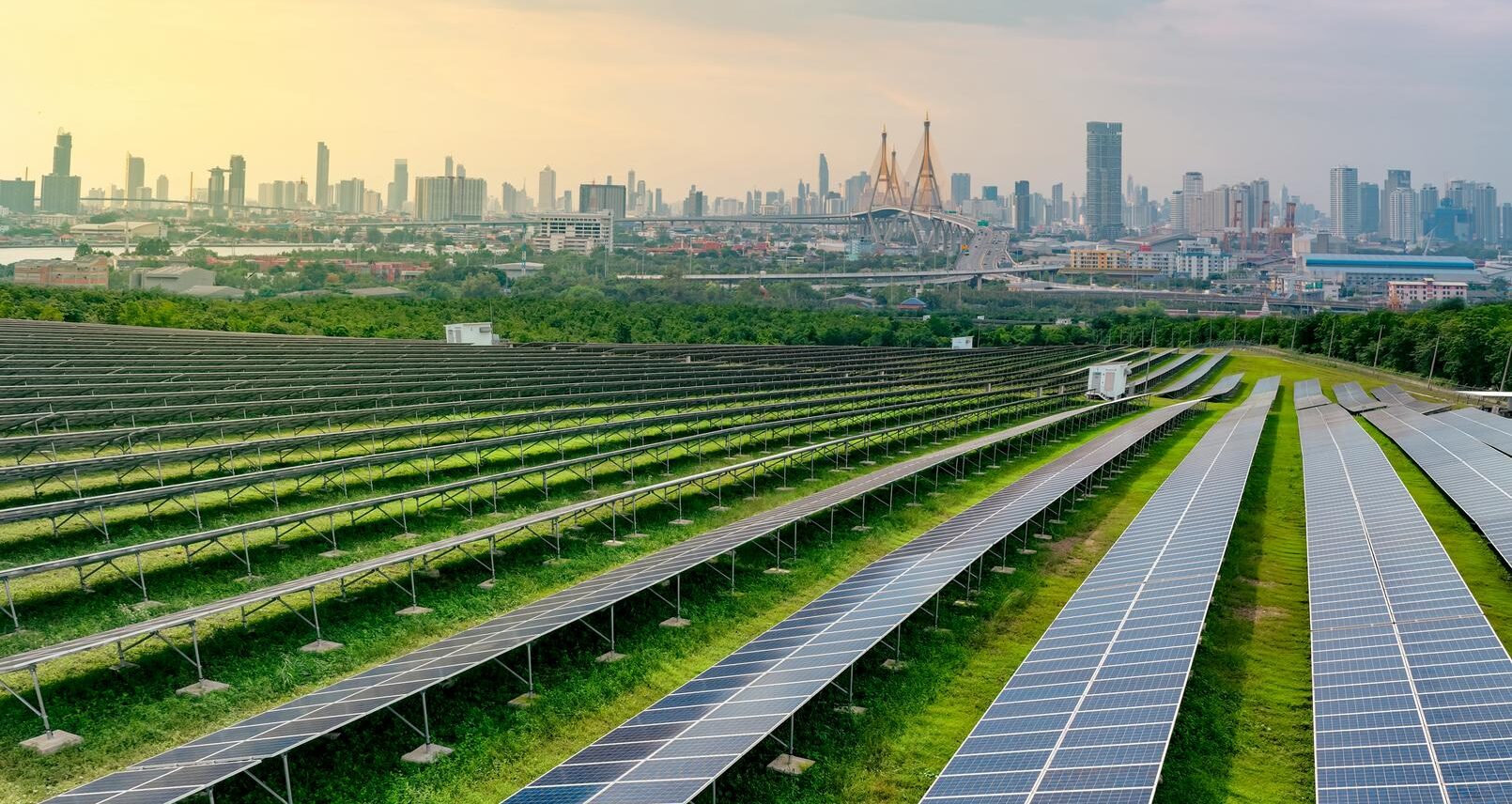News & Insights
Renewable energy transition: strategies for success
Transitioning from fossil fuels to renewable energy can be a complex process for campuses and buildings, especially for those tasked with guiding those properties into a sustainable future. This article outlines the challenges, technologies, and strategies to make facility managers successful.

For facility managers, navigating the renewable energy transition includes nuanced challenges and opportunities. By addressing these aspects thoughtfully, facility managers can effectively steer the shift to renewable energy and balance immediate operational needs with long-term sustainability goals.
This article helps address questions facility managers may have about getting from where they are now to a renewable energy future.
What should facility managers be thinking about when it comes to transitioning to renewable energy sources?
There is often an initial fear when considering the transition from fossil fuel-based systems. After all, facility managers are working with known quantities when it comes to reliability, operability, and maintainability, and a direct 1:1 replacement with renewable options is rarely possible. Entire systems and their operations may need to be rethought and redesigned.
For instance, transitioning from steam-based heating systems to low-temperature sources involves significant changes. The integration of new technologies like photovoltaics, microgrids, solid oxide fuel cells, or geo-exchange systems adds another layer of complexity.
As facility managers engage an energy transition, there is a huge education component not only for expanding their own knowledge, but also for educating their leadership and teams. Recognizing that the shift to renewable energy is inevitable—driven by the pursuit of cost savings, reduced carbon emissions, and evolving regulations—can be empowering. Proactively focusing on education can help facility managers prepare themselves and their teams for the changes ahead.
What technologies are part of the transition (and what should facility managers know about them)?
Exploring new systems and understanding their key points can spark confidence in facility managers as they navigate the transition to advanced technologies. Here are renewable energy solutions that are currently being integrated into facilities across North America:
Solar photovoltaic (PV) systems
Solar PV is one of the fastest-growing renewable energy technologies, and prices are dropping each year. Facility managers should know:
- Rooftop or ground-mounted options are available
- PVs can be combined with energy storage for increased reliability
- An assessment of roof structural capacity and available space is required
- Local zoning and permitting requirements may need to be considered
Wind turbines
While less common for facilities, small-scale wind turbines can be viable in some locations. Considerations:
- Require adequate wind resources and open space
- May face height restrictions or zoning challenges
- Can be combined with solar PV for hybrid systems
Combined heat and power (CHP)
Although not strictly renewable, CHP systems can significantly improve energy efficiency:
- Uses waste heat from electricity generation for heating or cooling
- Can run on renewable fuels like biogas or hydrogen
- Requires careful sizing based on facility heat and power needs
Heat pumps
Heat pumps are efficient heating and cooling technology that can be powered by renewable electricity:
- Air-source and ground-source (geo-exchange) options available
- Can significantly reduce natural gas consumption for space and water heating
- May require upgrades to building insulation and air sealing for optimal performance
Solid oxide fuel cells (SOFCs)
SOFCs are an emerging technology with significant potential for efficient, clean energy generation. Key points for facility managers:
- Generate electricity through an electrochemical reaction, not combustion
- Can run on various fuels including natural gas, biogas, hydrogen, or mixtures
- Highly efficient, with electrical efficiency around 60% and overall efficiency up to 90% when heat is utilized
- Produce lower emissions compared to conventional power sources
- Typically raises the gas bill, but dramatically drops the electricity bill
Onsite hydrogen production
Onsite hydrogen production using electrolyzers is an emerging technology, particularly valuable for applications that require a clean and decentralized hydrogen source.
- Hydrogen gas is generated directly at the site where it’s needed, eliminating the need for external supply chains to deliver hydrogen fuel to equipment like green generators.
- The process uses electrolyzers—devices that split water (H₂O) into hydrogen (H₂) and oxygen (O₂) through electrolysis, using electricity.
- This technology, while in use, is not yet widely available. Its future success depends on improvements in electrolyzer efficiency, cost reductions, and the availability of affordable renewable electricity.
Renewable natural gas (RNG)
RNG, also known as biomethane, is a sustainable alternative to conventional natural gas:
- Produced from organic waste sources such as landfills, wastewater treatment plants, and agricultural operations
- Chemically identical to conventional natural gas, allowing use in existing infrastructure
- Can significantly reduce greenhouse gas emissions compared to fossil fuels
- Usable in existing natural gas equipment, including combined heat and power systems
- May qualify for renewable energy credits or other incentives
- Supply can be limited and may require long-term contracts
Electric vehicle (EV) charging infrastructure
As part of the broader energy transition, EV charging can be a significant new component for parking structures, fleets, and campuses:
- Can be integrated with onsite renewable energy generation
- There are various charging speeds and connector types available
- May require upgrades to electrical infrastructure
- Can provide additional revenue streams or employee/customer amenities
Micro nuclear
While not yet widely available, small modular reactors (SMRs) and microreactors are emerging nuclear technologies that facility managers should be aware of:
- Compact design will allow for easier installation and scalability
- Enhanced safety features and reduced nuclear waste
- Can provide both electricity and process heat for industrial applications
- Regulatory and public acceptance challenges may affect deployment
Battery energy storage systems (BESS)
Battery storage is growing rapidly and can complement renewable energy sources. Key points:
- Helps manage intermittency of renewable sources
- Can reduce peak demand charges
- Various chemistries available (e.g., lithium-ion, flow batteries)
- Requires careful sizing, placement, and integration with existing electrical systems
Microgrids
For larger facilities or campuses, microgrids can integrate multiple renewable sources, and enhance resilience and energy independence. Key points:
- Can operate in island mode during grid outages
- Require sophisticated control systems and careful design
- Changing settings can throw off energy savings and performance
By incorporating these advanced technologies into their renewable energy strategies, facilities and campuses can diversify their energy mix, increase efficiency, and contribute to their organization’s sustainability goals. But, as facility managers know, planning a renewable energy transition must be approached holistically by assessing technologies for their ability to work across buildings with carefully planned implementation.
Where to get started with a renewable energy transition?
Get a baseline energy profile for all facilities
Whether managing a single building or an extensive campus of facilities, it’s difficult to develop a renewable energy transition plan without a solid baseline of how a campus is already using energy. This may involve conducting an ASHRAE level energy audit (1, 2, or 3), engaging in energy modeling, or starting with a thorough review of utility bills. These steps will help identify how energy is being used, identify opportunities for efficiency, and plan for renewable energy deployment. Assess not only peak energy needs but also usage patterns throughout the year, where energy is stored, and where it can be shared.
Perform a lifecycle cost analysis (LCCA)
A lifecycle cost analysis (LCCA) evaluates the total cost of a renewable energy project over its entire lifespan. This analysis includes initial investments (CapEx), operation and maintenance costs (OpEx), and eventual decommissioning or replacement expenses. Additionally, LCCA considers incentives and rebates, projected energy output, and cost savings from reduced reliance on conventional energy sources. The goal is to provide a comprehensive understanding of the long-term economic viability and financial benefits of transitioning to renewable energy sources.
Be able to lead informed decisions
Facility managers need to be well-educated in the various renewable energy technologies and strategies available to make informed decisions and effectively lead the facility’s transition. This can include continuous learning through industry conferences, webinars, and publications; pursuing certifications such as the Certified Energy Manager (CEM) or courses offered by professional organizations like ASHRAE; and networking with peers and experts in the field to share knowledge and experiences. You can also hire an expert—like Salas O’Brien—to guide you through the decision-making process.
Strategies for overcoming challenges in an energy transition
Navigating a renewable energy transition has a number of challenges. Here is a breakout along with strategies for addressing them.
Initial cost and financing
Challenge: High upfront costs for renewable energy installations can be a significant barrier.
Strategy: The transition to renewable energy in existing facilities requires shifting costs from operational to capital. This has implications for both financing and lifecycle management. Establish a clear cost-benefit analysis that includes system paybacks, savings in personnel and maintenance, peak energy savings, reductions in water consumption, and carbon emission management costs. Additionally, include a risk assessment of the consequences of deferring action, such as the failure of existing systems. Explore financing options such as power purchase agreements (PPAs), leasing systems without owning them, green bonds with low interest rates, and energy-as-a-service (EaaS) provided by third-party vendors with minimal upfront costs. Leverage federal tax credits like the ITC in the US, local grants, utility rebates, and PACE financing (US) to reduce initial expenses.
Interconnect utility contracts, regulatory compliance, and permitting
Challenge: Producing onsite energy requires establishing contracts with local utilities to sell additional electricity back to their grid. Additionally, navigating local, state, and federal regulations and obtaining necessary permits can be time-consuming and complex.
Strategy: Partner with a trusted expert—like Salas O’Brien—who can integrate all these elements seamlessly. This partner should assist with negotiating interconnect contracts with your local utility, ensuring compliance with all regulatory requirements and streamlining the permitting process. Their expertise can save time, reduce hassle, and ensure a smoother transition to onsite energy production.
Stakeholder buy-in and education
Challenge: Change can spark resistance within an organization—especially when the needs, goals, and implementation are not well understood.
Strategy: Collaborate with your communications team to develop a comprehensive, transparent communication plan. (And keep in mind that you will become fatigued with the message long before it reaches everyone it needs to.) Provide ongoing education and training to build confidence and support for the transition within your team and organization. Regular updates, workshops, and feedback sessions can help ensure everyone is informed and engaged throughout the process.
Maintenance and operations
Challenge: Maintaining and operating new renewable energy systems requires specialized knowledge.
Strategy: Develop a comprehensive maintenance plan and invest in training for your facility management staff to resolve the knowledge gap inherent with new technologies. In some cases, it is possible to contract with service providers specializing in renewable energy systems for regular maintenance and troubleshooting to ensure optimal performance.
Scalability and future expansion
Challenge: Ensuring that renewable energy systems can scale with your facility’s growth and future energy needs.
Strategy: Design systems with scalability in mind that allow for future expansion. Regularly review and update your energy plans to align with organizational growth and technological advancements, ensuring long-term flexibility.
By anticipating these challenges and implementing effective strategies to address them, facility managers can direct a smoother transition to renewable energy, ensuring long-term success and sustainability for their campuses and buildings.
For media inquiries on this article, reach out to Stacy Lake, Director of Corporate Communications.

Duc Bui, PE
Duc Bui is an expert in the electrification of healthcare facilities. A leading provider of electrical engineering solutions and an innovator in using low voltage DC power for LED lighting , he holds a US Patent on Direct Current Power Delivery System. Duc specializes in healthcare facilities and pharmaceutical facilities with a strong presence in California serving large corporations such as Kaiser Permanente, Abbott Vascular, Tenet, University of California Irvine, and the University of Southern California. Duc serves as a Principal for Salas O’Brien. Contact him at [email protected].

Tom Iskra, PE, LEED AP
Tom Iskra has over 20 years of experience in project management, design and construction of innovative projects that maximize efficiency and minimize the impacts on the environment. Tom is actively involved with decarbonization efforts at Tufts University, Northeastern University and various public institutional campuses across the Northeast. Tom holds a Bachelor’s degree from the University of Connecticut and Master’s degrees from University of California, Berkeley and Harvard University’s Graduate School of Design. Tom serves as a Principal at Salas O’Brien. Contact him at [email protected]

Marianna Moores, WELL AP, LEED AP, ActiveScore AP
Marianna Moores is a leader in the field of ESG consulting. With her unwavering commitment to sustainability and profitability, she revolutionizes the way businesses approach their operations. By leveraging data-driven insights and scientific methodologies, Marianna empowers clients to harmonize their environmental and social responsibilities with their financial success. Marianna has over 15 years of experience in sustainability consulting, including third party certifications, corporate sustainability planning, and ESG bridge services. Marianna holds a Bachelor of Science in Architecture as well as an MBA from Georgia Institute of Technology with focuses in sustainability, innovation, and inclusive technology. She serves as an Associate Vice President at Salas O’Brien. Contact her at [email protected].

Terry Tullis, PE, LEED AP
Terry Tullis has 19 years of experience performing ASHRAE energy audits, energy modeling, commissioning, and asset management services. Terry specializes in providing sustainability services to federal clients, including NASA, Department of Energy, Department of Defense, General Services Administration, and the National Institutes of Health. His focus is on delivering a positive ROI to his customers through proactive energy efficiency and maintenance management practices. He holds a Bachelor of Science in Mechanical Engineering from the University of Central Florida. Terry serves as Director of Sustaining Engineering Services and Vice President at Salas O’Brien. Contact him at [email protected].